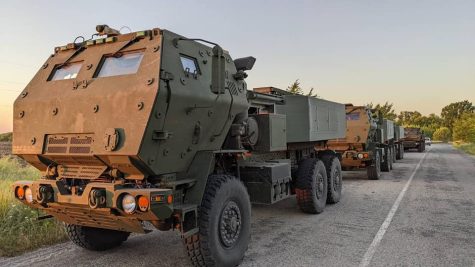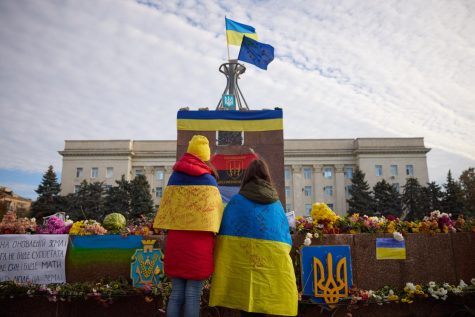Your donation will support the student journalists of Delaware Valley Regional High School. Your contribution will allow us to attend conventions, purchase equipment and cover our annual website hosting costs.
Phase 2
February 24, 2023
The Russian offensive in Donbas (April 18, 2022- present)
After weeks of frustration facing the offensive in Kyiv, Putin finally gave the go-ahead for the withdrawal of Russian troops in the area.
Instead, his troops would be focusing on a new target: the Donbas region, located in eastern Ukraine, a move which had been long anticipated. For years, Russia has been keen to completely annex the area, and the region itself is home to two Russian-backed separatist “republics.” Donbas also is home to valuable resources and its location, if taken by the Russians, could also serve as a “land-bridge” between the region and Crimea.
Tactics aside, the Donbas region also holds a more sentimental value for the Russians, as the region is home to a large population of ethnic Russians.
The Russian’s push for the region signaled the dawn of a new phase of this invasion, and shortly after, Russian and Ukrainian forces began to clash.
In late May, the Russians took control of the city of Mariupol, located on the border between Crimea and Donbas, and the siege was received as a much-needed victory for Putin.
Similar to Kharkiv, the Russians showed no mercy towards the structure of the city, and much of Mariupol soon became rubble.
The Russians pushed on, and with each passing week, more and more cities in the region were falling to Putin’s troops. Yet as of now, the Russians have failed to gain control of the entire region.
The Ukrainian counterattack in the north (Sep 8-October, 2022)

After Ukraine publicly announced that it would be sending reinforcements to southern Ukraine, Russian troops were deployed to the area as well.
Yet little did Putin know that by moving Russian troops to the south to combat the alleged Ukrainian
advancement, he was simply playing into Ukrainian hands.
As while the Russians were distracted in the south, Ukraine quickly launched a surprise counterattack in northeastern Ukraine, throwing the Russian army into chaos and disarray.
The counterattack was an instant Ukrainian success, and on the evening of Sep 8, Ukrainian President Volodymyr Zelensky stated that Ukrainian forces had even advanced all the way to Balakyliva, a town located just 35 kilometers from Kharkiv.
In the following days, Ukrainian sources confirmed that dozens of towns and villages had been liberated in the Kharkiv region, including the strategically important towns of Izyum and Kupiansk.
A crucial part of Ukraine’s counterattack that contributed to its success was due to the recent weaponry systems that the defenders had gained. Especially notable were the HIMARS (High Mobility Artillery Rocket Systems) which the Ukrainians had received from the United States. Motivated by the momentum they had received following the counterattack, the Ukrainian army continued to advance, which in turn forced many Russian troops to retreat.
The Ukrainian counteroffensive in the north was a somewhat bold move- and an ultimately triumphant one.
By early October, Ukrainian officials announced that the counterattack had even resulted in the defenders reclaiming 1,170 kilometers of land.
The attack on the Crimea bridge (October 8, 2022)
In the early hours of October 8 (around 6:00 a.m., Kyiv time), a truck made its way across the Kerch Bridge, a key bridge that connected Russia with its troops fighting in southern Ukraine.
Alongside the truck, on the railroad section of the bridge, rode a train.
There is no doubt, this (the Crimea bridge attack) is an act of terrorism aimed at destroying Russia’s critical civilian infrastructure — Vladimir Putin
Unbeknownst to the Russians, the truck was laden with explosives.
Around 6:07 a.m, the bomb detonated.
The explosion had such a massive impact that it also ruptured fuel tanks in the adjacent train, and engulfed it in
flames. The impact of the bomb also caused a larger portion of the roadway to collapse into the sea below.
The incident resulted in four deaths, and was a massive blow for the Russians.
Repair of the bridge ended up taking months, and only was fully restored and reopened in late January.
Shortly after the attack, an investigation was launched to attempt to explain what – or who- was behind the attack.
And it was soon revealed that the whole incident was orchestrated by the Ukrainians. Putin was enraged, and deemed the defenders’ attack to have been an “act of terrorism.”
Ethical or not, the attack resulted in a critical connection between Russia and many of its troops being destroyed.
The reconquest of Kherson (November 9-11, 2022)
On March 2, the city of Kherson succumbed to Russian invaders- the first city to fall during the invasion.
However, over eight months since its capture, Ukrainian forces launched a campaign to liberate the city in early November. This decision arrived following a highly successful counterattack in the northeast which led to the regain of much Ukrainian territory.
On November 10, news broke that Ukrainian forces were making great progress towards the city, and had

liberated several towns and villages in proximity to Kherson.
Feeling threatened, many Russian troops began to backpedal from the area. This response gave the Ukrainians the momentum they craved to keep pushing on, and soon advanced further into the Kherson oblast.
The Russians in the area soon became disorganized, and continued to retreat, and struggled to resupply as HIMARS strikes progressively disabled the ability of heavy vehicles to use the bridges crossing the Dnieper River, which separated the Kherson garrison from the main Russian force.
And on November 11, the Russian Ministry of Defense announced that 30,000 soldiers and all military equipment in the Kherson area had been relocated across a river in an organized withdrawal.
The Russian troops that remained were increasingly vulnerable to Ukrainian drone and targeted HIMARS strikes, and were finally forced to withdraw.
The following day, Ukrainian forces successfully entered and liberated the city of Kherson.
Crowds of civilians swarmed the streets to pay gratitude to the Ukrainian forces, and Volodymyr Zelensky himself even traveled to Kherson to witness the Ukrainian flag being raised over the city for the first time in months.